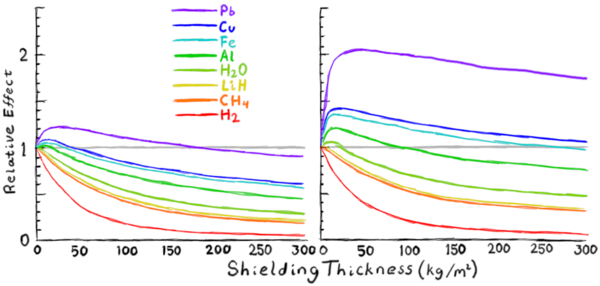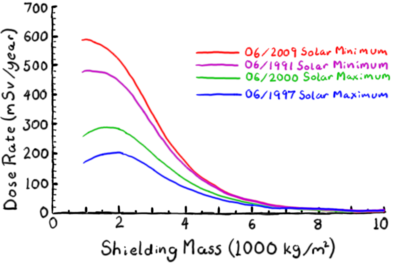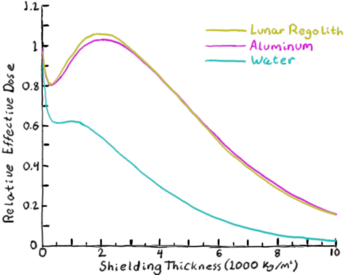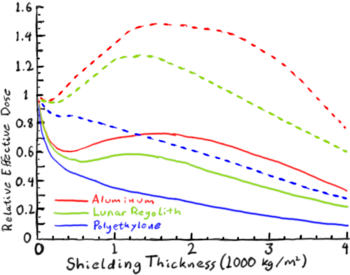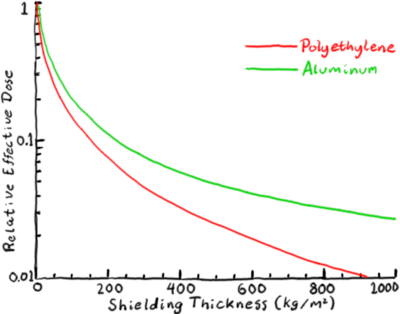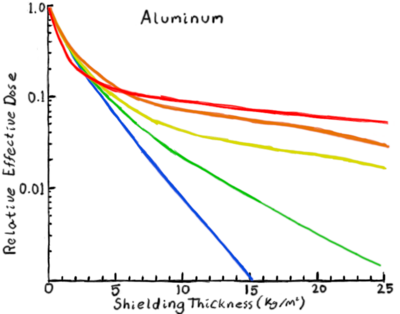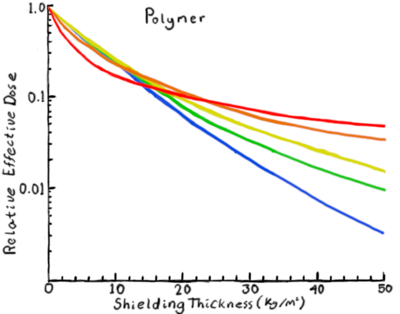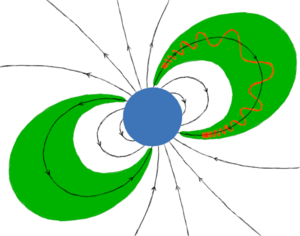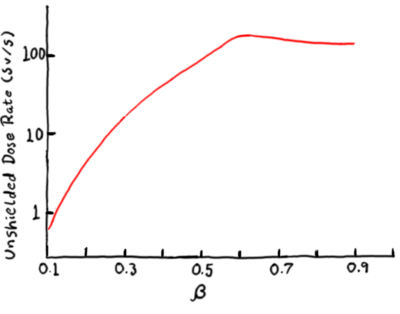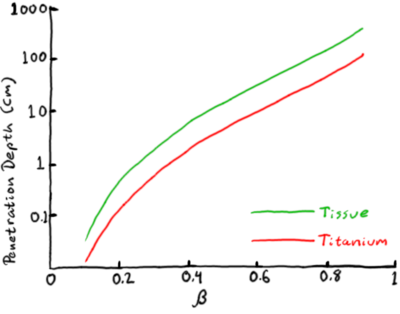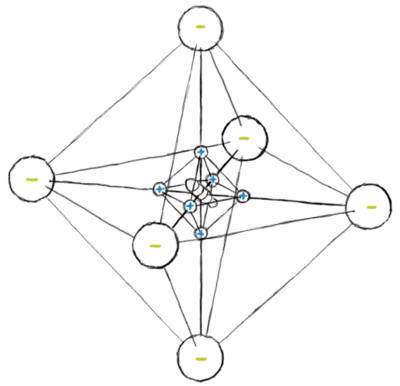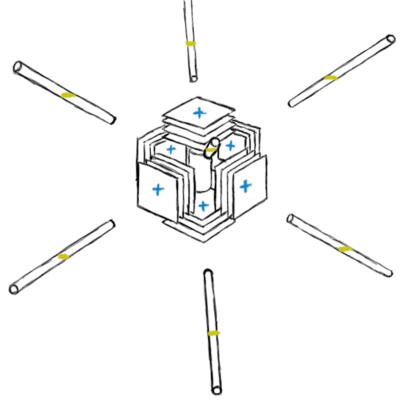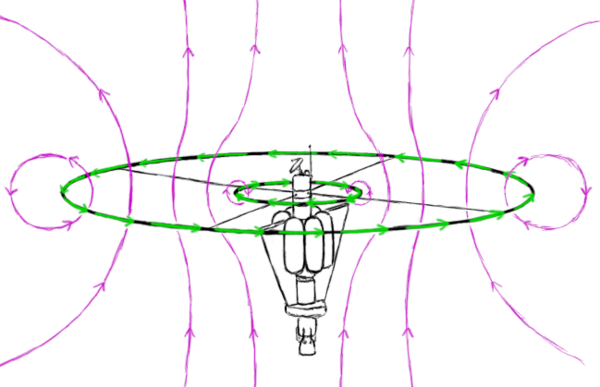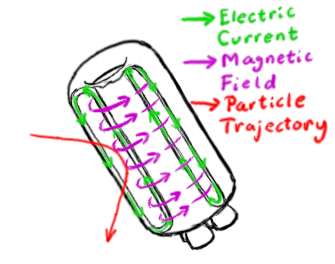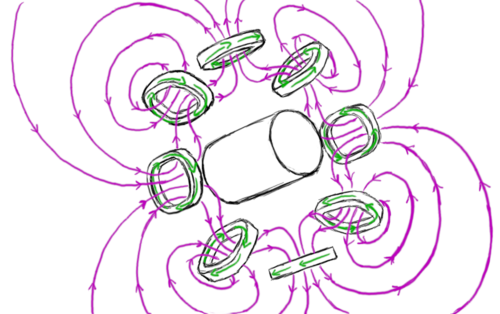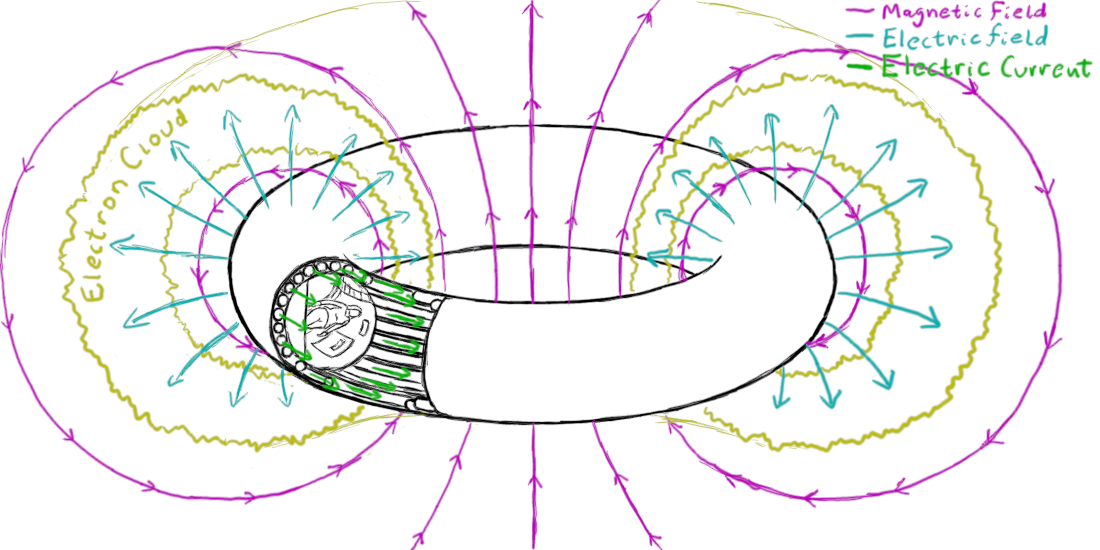Space Radiation
Space is trying to kill you. It tries to kill you in many different ways. One of those ways is to flood itself with dangerous radiation that can kill biological organisms, damage or disable electronics, and degrade some kinds of materials.
Galactic Cosmic Rays
Space is filled with energetic charged particles – primarily protons (~90%) and alpha particles (~9%) but also including other light and medium ions. These are not associated with any immediate stellar environment but instead are thought to come from outside of our solar system, originating in supernovas, neutron stars, active galactic nuclei, quasars, and gamma ray bursts.
These cosmic rays generally have much higher energies than other forms of space radiation. A typical energy common to one of these particles would be around several hundred MeV to a GeV. Some have lower energies; these are often shielded from solar systems or planets by the sun's magnetic field, the solar wind, or planetary magnetospheres[1]. More notorious, however, are those with higher energies. Often much higher. The most energetic cosmic ray ever measured (as of 2024) had an energy of eV, or around 50 joules – the energy of a major league baseball pitch in a single particle[2].
High energy massive particles, such as these cosmic rays, will have a high gyroradius, so they will not be strongly deflected by magnetic fields. Consequently, more energetic cosmic rays can pierce a planets magnetosphere to deliver radiation dose to those in orbit. Lower energy cosmic rays can be deflected by either magnetic fields that cover a very large amount of space (such as those around planets) or magnetic fields with a very high field strength.
Cosmic rays come through at a steady sleet, delivering on the order of 1 – 2.5 mSv/day[3][4]. This dose is not delivered fast enough to cause acute radiation sickness, but is roughly two orders of magnitude higher than the natural background radiation dose on Earth. This can cause issues with chronic radiation exposure. The main concern is an increased risk of cancer. However, experiments on rodents exposed to radiation from a particle beam simulating long duration exposure to cosmic radiation also suggests the possibility of reduced cognitive function after several months in deep space[5]. The cosmic ray dose rate is lower in times of high solar activity as the increased solar wind prevents more cosmic rays from entering our solar system. A planetary magnetosphere like that of Earth can deflect enough of the lower energy cosmic rays to make a noticeable difference in the dose rate[4], often in the 0.2 – 1 mSv/day range in low orbits below the main radiation belts, although this depends strongly on the latitudes through which the satellite passes. Equatorial orbits offer the best protection, and polar orbits pass through the radiation belts where the cosmic rays are deflected to. A significant amount of this shielding is also afforded by the planet itself, which will block cosmic rays from close to half the sky for close orbits.
Cosmic rays passing through a computer chip can cause transient errors that can result in a glitch in operations or a corrupted bit of memory. High doses of radiation can also cause permanent damage to elctronics.
Shielding Against Cosmic Rays
Because they can have such a high energy, cosmic rays can be difficult to shield against. A typical cosmic ray will pass through several tens of centimeters of solid or liquid matter before striking an atomic nucleus. The cosmic ray has so much energy that this shatters the nucleus, sending nuclear fragments spraying through the material and possibly (depending on the cosmic ray's energy) creating exotic particles such as pions or kaons as well as energetic electrons and positrons (and possibly the odd anti-proton or anti-neutron as well). The nuclear fragments that come out at lower energy slow down and stop inside the material before colliding with another nucleus, producing a very high ionization density near the end of their track that can cause significant radiation damage. Higher energy fragments, along with the pions and kaons, are likely to continue the radiation cascade by slamming into more nuclei every few tens of centimeters or so and making more showers of nuclear particles until the energy of the primary cosmic ray is distributed among so many secondary particles that there is not enough energy left to shatter additional nuclei. Meanwhile, the high energy electrons and positrons make extensive electron-gamma showers.
On Earth, we have the benefit of ten tons of air over every square meter of ground to help intercept and stop this space radiation. This is enough to stop almost all of the radiation showers, although the occasional particle does reach the ground. One additional complication is that in air, the pions can fly far enough that they decay into muons before smacking another nucleus. Muons do not strongly interact with nuclei and don't ionize stuff too much, so they make up a lot of the stuff that reaches the ground. However, cosmic rays initially interact with the atmosphere at altitudes of several tens of kilometers[6]. The great distance that the particles have to travel to reach the ground means that even most of the muons decay before reaching us, and the electrons the muons decay into are quickly stopped (the pion and muon decays also produce neutrinos, which are not stopped. By anything. Even the ground. They just go right through the Earth without interacting, and consequently are of little interest when considering the effects of radiation).
On airless bodies such as the Moon, the dose will be cut in half because the body will block out half the sky, absorbing any radiation coming from that direction. The thin atmosphere of Mars is found to cut the dose in half again, for only approximately one quarter of the dose in space[7].
In space, it is expensive to carry this much shielding. Even worse, a moderate amount of shielding might make things worse, by allowing the impacting cosmic rays to produce more secondary particles[8]. For light elements, shielding seems to give some moderate benefit for low thickness but once the thickness reaches on the order of 300 - 500 kg/m² the dose often plateaus or even rises over a considerable range; often only declining again at thicknesses of around 2 tons per square meter or more. The specific details depend on the material and the spectrum of cosmic rays for this part of the solar cycle. Because the way that cosmic radiation damages cells is not known in detail, the model used for radiation damage can significantly impact the conclusions about how much good (or harm) a given amount of shielding does. The best shielding uses hydrogen-rich materials with only light elements to limit the secondary radiation. One of the preferred materials is polyethylene, composed of two hydrogens for each carbon atom and naught else[9]. Water is also good, and liquid hydrogen, if you can store it, provides the best shielding of all. On a planetary or sub-planetary body lacking an atmosphere, native ice or regolith could be used as shielding by piling it over and around any facilities[10][11].
|
Relative effect of radiation on biological tissue behind a given areal density of material[8]. The results of two models are shown. On the left is the standard risk assessment method using quality factor as a function of linear energy transfer. On the right is a track structure repair kinetic model for mouse cells. |
Dose rates for atmospheric shielding[12]. This is the dose an astronaut would take if surrounded by this areal density of air as measured in Earth's atmosphere at different altitudes. |
Relative effect of radiation (compared to no shielding) behind different thicknesses of water, aluminum, and lunar regolith[10]. |
|
Comparison of aluminum, lunar regolith, and polyethyene shielding as a function of thickness at both solar maximum and solar minimum galactic cosmic ray conditions[11]. |
Solar Radiation

Solar Energetic Particles and Solar Particle Events
The sun is an erratic source of high energy particles, ranging from keV to GeV energies. These solar energetic particles or SEPs, as they are called, are often produced in solar flare or coronal mass ejection events (see below). Such an event that produces SEPs is called a solar particle event. SEPs are primarily protons, with some alpha particles and a small amount of light and medium ions. As protons below about 30 to 50 MeV energy can't penetrate even thin spacecraft hulls, we are mostly concerned about those SEPs in the 100 MeV to GeV range. When the sun is quiescent, SEPs in this energy range are negligible compared to cosmic rays. However, in a solar particle event the flux of SEPs can jump by two, four, even six orders of magnitude, posing a significant radiation hazard to anyone in space and not protected by a planetary magnetosphere. The Earth's magnetosphere does a good job stopping SEPs from reaching close orbits at low latitudes, but funnels the deflected particles to the poles where they produce auroras. SEPs do not penetrate Earth's atmosphere; the atmosphere on Mars has been shown to reduce the dose of a solar particle event by a factor of 30[14].
Because SEPs have generally lower energies than galactic cosmic rays, less material is required to shield against them. Further, because solar particle events are transitory, it is feasible to shield a small portion of a spacecraft in which the crew can huddle for the duration of an event without requiring shielding over the entire spacecraft.
|
Relative dose of solar energetic particles as a function of thickness of aluminum and polyethylene shielding[15]. |
Solar Wind
The solar wind is an outflowing plasma streaming from the Sun's outer layer called the corona. These are low energy particles, generally ranging from sub-keV to several keV, and quite incapable of penetrating spacecraft hulls or space suits. This solar wind is of little concern from a radiological perspective.
Solar Flares
Solar plasma is a soup of free charged particles, and charged particles do not cross magnetic field lines. If the plasma is dense enough and moving swiftly enough, it will drag the magnetic fields with it rather than being deflected by the fields. In the turbulent plasma of the sun's upper layers, this results in the magnetic fields getting all twisted up and looping back on themselves. While this turbulence helps to create a strong solar magnetic field by this churning action (called the solar dynamo), twisted up fields can sometimes snap and smooth out in a process called magnetic reconnection. A magnetic reconnection will release considerable amount of energy as the fields re-arrange themselves into a more relaxed state over a period of usually five to ten minutes, but ranging from tens of seconds to hours. This energy takes the form of a burst of highly energetic particles and x-rays – a solar flare.
The x-rays from a solar flare can pose a radiation risk. The total dose varies considerably, but at 1 AU a dose of 0.05 to 0.2 of a Gy to unprotected people is not uncommon, and doses as high as 2 Gy are possible with a suggested occurance of perhaps once every ten years[16]. When the x-rays hit the Earth's upper atmosphere they are absorbed. This can cause temporary interference with shortwave radio communication and expand the outer layers of the atmosphere to cause additional drag on satellites in low orbit. Unlike SEPs or other charged particles, these x-rays are not affected by magnetic fields and are unhindered by the Earth's magnetosphere. They are, however, swiftly absorbed by air and are rapidly blocked by our planet's atmosphere.
It is estimated that solar flares which deliver a dangerous dose of SEPs are roughly 50 times less frequent than those which deliver a dangerous x-ray dose[16]. Still, the dose from flare SEPs can still be dangerous[17].
Solar flares occur more frequently during the solar maximum of the 11-year sunspot cycle. Sunspots happen with strong bundles of trapped magnetic fields emerge from the sun's atmosphere. Consequently, solar flares often occur near sunspots.
The x-rays from solar flares are best shielded using heavy elements. This is the opposite of shielding against particle radiation (such as galactic cosmic rays, SEPs, or radiation belt particles) where heavy elements can end up making things worse. If you are going to shield against x-rays you might consider putting a thin layer of heavy metal on the inside of your particle shielding, where the particle shower has hopefully already attenuated into low enough energy particles to not significantly multiply within your x-ray shield.
|
Relative dose of solar flare x-rays for a given thickness of polymer or aluminum shielding[16]. Different curves show different flare spectral distributions of x-rays. | |
Coronal Mass Ejections
The churning magnetic field of the sun will occasionally launch large loops of detached magnetic fields and solar plasma out into space, called a coronal mass ejection. This is often accompanied by solar flares as the detachment of the field lines requires magnetic reconnection. The launched plasma from a fast coronal mass ejection can move faster than the speed of sound in the solar wind. This leads to a shock wave at the front which can accelerate ions to high speeds and create a solar particle event. However, not all coronal mass ejections are spat out quickly enough to do this. The solar particle events associated with coronal mass ejections often last for a few days, although the period of maximum radiation intensity might be over in several hours. The dose over the entire event can vary considerably, from a fraction of a cGy up to ten or more Gy, with an equivalent dose in Sv roughly double the physical dose in Gy[14][18][19][20].
It takes a few days for the plasma in a coronal mass ejection to reach Earth. When the mass of plasma impacts the Earth's magnetosphere, it compresses the magnetic field. The ramping magnetic flux at ground level can induce strong currents in long conductors, such as power lines, and this can lead to blackouts and damage to power grid infrastructure. The resulting geomagnetic storms can also mess with the ionosphere, causing radio blackouts. Not all coronal mass ejections are aimed at Earth – if the plasma blob is not aimed at you it will pass you by and you won't be affected.
Coronal mass ejections are most common during solar maxima – the phase of the sun's 11 year sunspot cycle when it is most active.
Solar Ultraviolet Light
The sun puts out a steady glow of light. Most of this is in the visible and infrared part of the spectrum, but some is ultraviolet. The energetic particles of ultraviolet light can break apart many kinds of molecules. Over time, anything organic which is exposed to ultraviolet light will be degraded. Rubber will lose its elasticity and crack, plastics will yellow and crumble, dyes will lose their luster and fade, fabrics will weaken and become fragile. Direct exposure to the full glare of the sun, unshielded by any intervening material or atmosphere, can cause sunburns more rapidly than you would expect – but if you find yourself in this situation, sunburn is probably the least of your concerns.
Ozone in the Earth's atmosphere absorbs much of the ultraviolet light headed our way, including the more dangerous shorter wavelengths. This helps to make our world more livable.
Flare Stars
Our sun is not the only star in space. If you find yourself around another star, many of the same phenomena can occur to produce space radiation. Hotter stars make more ultraviolet light. However, hotter stars have a thinner convective layer at their surface. As you might remember from previous sections, it is the convective boiling of the solar plasma that makes solar magnetic fields from the dynamo effect, and which twists up the magnetic fields in ways that produce solar flares and coronal mass ejections. Cool stars such as red dwarfs can be convective everywhere, with strong magnetic fields and frequent, powerful flares. Such stars can produce powerful but erratic bursts of space radiation from their various solar particle events and x-ray flashes. Meanwhile, hotter stars starting at mid-range spectral class F main sequence stars are not convective anywhere and will likely lack significant flares and solar particle events.
Planetary Radiation Belts
Many planets have planetary magnetic fields. Usually, these have a simple magnetic north pole and magnetic south pole on opposite sides of the planet. (The magnetic north and south poles do not necessarily align with the rotational north and south poles – in fact, on Earth, it is the magnetic south pole that is closest to the rotational north pole.) In the field line approximation, "lines" of magnetic field (each representing a certain amount of magnetic flux) emerge from the magnetic north pole to go out into space, spread out, then curve around and come back in through the south magnetic pole.
Charged particles spiral around magnetic field lines. Where the lines become more concentrated and the field gets stronger, the particle will spiral around faster and the energy for that increased spiraling speed will come from the energy of its speed along the field line. If the field gets strong enough, the particle will stop drifting along the field line when all its kinetic energy ends up in the spiraling motion after which the particle will start drifting the other way along the field line. In this way, charged particles can be reflected from areas of strong fields.
When you combine these facts, you get particles stuck in the magnetic field of the planet that drift back and forth along the field lines and get reflected from the stronger fields at the poles. When you get many particles trapped in this way, you get a radiation belt.
A charged particle that comes into a planet's magnetic field from the outside will always get bent back so that it flies away, as long as the field itself doesn't change. This means that any planetary radiation belts are either made up of radiation that was produced inside the planet's magnetic field, or that the incoming radiation distorted the field enough to become captured. The former kind can happen deep inside the planet's field, the latter are generally out near the edges. Particles in the field with enough energy to go deep into the polar region fields and encounter the atmosphere will be stopped by all that air they hit, and produce colorful auroras in the process. This puts an upper limit on the energies of particles you will encounter in a radiation belt.
Planetary radiation belts often have changing radiation conditions, both fluctuating with time and varying across space as you go in and out across magnetic field lines. A given "shell" of field lines that reach the same altitude generally have close to the same intensity and spectrum of radiation within them, however.
Earth
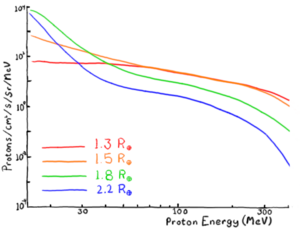
Earth has two radiation belts, known as Van Allen belts after their discoverer. The inner belt consists mainly of protons with energies ranging up to 400 MeV. These are created by cosmic rays – when a cosmic ray collides with the upper atmosphere, it can produce neutrons which can scatter out of the air and into space. Being uncharged, neutrons pass unhindered through the Earth's magnetic field. Free neutrons are unstable, however, and decay into protons and electrons with a 15 minute half life. If this happens within magnetic field lines that loop out to about 0.2 to 2 Earth radii in altitude from the planet (or 1.2 to 3 Earth radii from Earth's center, using the standard method of measurement), the protons can become trapped. This is what forms the inner belt.
The outer belt forms from electrons leaking in from the solar wind and accelerated by waves in the space plasma. The outer belt is much more variable, and can change quickly based on space weather conditions. It extends across field lines that loop out to about 3 to 10 Earth radii altitude (4 to 11 Earth radii from the Earth's center).
Maximum dose estimates for both the inner and outer belt range from a dose of approximately 0.2 Gy/hour to 0.5 Gy/hour to individuals and equipment with 20 kg/m² of shielding[22][23], although shielding of 250 kg/m² will reduce this to 0.05 Gy/hour.
Jupiter
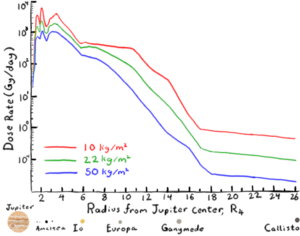
Jupiter has one of the largest and strongest magnetic fields of any planet in the solar system. Like that of Earth, it will trap particles from the solar wind and the decay products of cosmic neutrons. However, what really sets Jupiter's radiation belts apart is what happens because of its moon, Io. Io is extremely volcanic, and regularly erupts fountains of sulfur dioxide into space. This gas is then ionized by ultraviolet sunlight, producing positively charged sulfur and oxygen ions. These ions spread out to form the Io plasma torus. Electric currents within the torus, driven by Jupiter's rotation, accelerates ions and electrons to high speeds and can produce dangerous radiation. Jupiter's radiation belts are not as well understood as those of Earth, but data suggests that the particle energies are higher than those of the Van Allen belts and that the doses can be around a thousand times as intense[25][26]. The radiation is most intense closer to Jupiter, reaching a maximum of over 300 Gy/hour near Amalthea and other inner moons, approximately 20 Gy/hour at Io, 12 Gy/hour at Europa, 10 Gy/day (0.4 Gy/hour) at Ganymede, and 0.4 Gy/day at Callisto[24] (all assuming 10 kg/m² shielding). These doses are for the moon's orbits, presumably if you are on the moon the dose will be approximately halved (on average) because the moon will be shielding half the sky. However, the interaction's of the radiation with the moon's orbits is complicated, and generally one side (often the leading side) gets irradiated more than the other. This suggests that a spacecraft for a Jupiter mission could benefit from directional shielding, pointing its thicker shielded cap in the direction from which more radiation is incident – although you would still probably want substantial shielding from all directions!
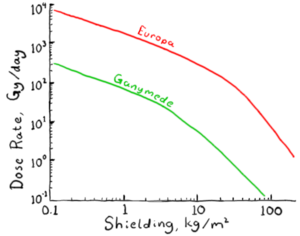
Other Planets
All the planets in our solar system with a substantial magnetic field have radiation belts to some degree. The best known outside of Earth and Jupiter are the radiation belts of Saturn, which were studied extensively by various probes, particularly the 13 year Cassini mission. Saturn's belts are complex, with gaps due to absorption by its moons and rings and different sources and features in different regions[27]. Like Jupiter, Saturn's radiation belts are largely driven by a plasma torus, this time sources from water vapor escaping from the moon Enceladus although cosmic ray decay protons also have a contribution. Saturn's rings block radiation that passes through them, so that the radiation belts end where the field lines pass through the rings separating the radiation into a belt outside the rings and one inside the rings. Little work appears to have been done on estimating the dose that instruments, equipment, or people would accumulate when passing through the Saturn radiation belts.
Compared to Earth, Saturn, and Jupiter very little is known about the belts of Uranus or Neptune. Mercury, Venus, Mars, and most of the various giant moons have fields far weaker than that of Earth, and lack radiation belts. Ganymede is an exception, having a small magnetosphere within Jupiter's powerful fields that has a modest trapped radiation belt[28][29].
Relativistic Travel
Space is not truly empty. It is filled with a very diffuse plasma. In between stars, this is called the interstellar medium (or ISM). Within a star system, it is the solar wind. The density of the plasma varies considerably depending on the environment, but is roughly one proton (and one electron) per cubic centimeter.
if you are traveling between stars at relativistic speeds, from your standpoint you are not moving and the ISM is moving at, past, and through you at those relativistic speeds. In essence, you have managed to turn the entire universe into a particle beam, and the parts in front of you are aimed right at you!
Low relativistic particles are fairly easy to shield against. A thin layer of just about anything will bring them to a stop. And even if they do get to you, their main hazard is radiation burns to your skin because they cannot reach deep organs to cause radiation poisoning. But as your speed increases, the particles will be hitting the front of your spacecraft faster and faster and they will penetrate more and more shielding material ... and more of you. One estimate of the dose and penetration is shown below; at 50% of light speed the ISM particles will be passing all the way through your body and delivering dose to your bone marrow and central nervous system where the really bad radiation exposure stuff happens. As you go faster and faster you need a thicker and thicker radiation shield in front of you to stop these particles[30][31].
More details on the hazards of relativistic travel can be found in Interstellar_Medium_Shielding.
|
The rate at which an unshielded individual will take radiation dose as a function of speed relative to light speed[31]. |
Stopping distance of protons in titanium and living tissue as a function of speed relative to light speed[31]. |
Extreme Astrophysical Environments and Phenomena
There's a lot of crazy stuff out there. Stuff that often features extreme conditions and exotic physics that can result in high radiation environments. Because people will not visit any of these sites in the near future, there is little urgency for quantifying the radiation hazards, in terms of dose or shielding. So this section will be fairly high level, giving qualitative descriptions of the kinds of hazards that can be encountered.
White Dwarfs
A young white dwarf will be much less luminous than its parent star. However, it will be much hotter with most of its radiated power in the ultraviolet and soft x-ray regions of the spectrum. Radiation of this nature can be dangerous to unprotected skin, but then so is space so this feature is probably not much of a concern. The shielding of even a space suit or thing spacecraft hull should suffice for protection. As the white dwarf cools, both the luminosity and the proportion of its emitted heat as x-rays and ultraviolet drops.
White dwarfs have magnetic fields ranging from between 0.2 T and 100 kT. This is well above the field of Earth, which raises the possibility of strong radiation belts around these objects.
Infalling matter from an accretion disk – possibly supplied by a closely orbiting companion – can radiate strongly in the ultraviolet and x-ray part of the spectrum as it spirals in. Instabilities in the rate at which the accretion disk is heated can lead to significant changes in brightness and radiation from the disk in a process called a dwarf nova. As material fall on the white dwarf, it leads to a build up of material. If hydrogen or helium from this accretion builds up sufficiently it can ignite as a wave of thermonuclear fusion engulfs the star, producing a classical nova explosion. If enough material builds up that the pressure causes fusion in the carbon and oxygen that makes up the majority of the white dwarf star, the entire star can be consumed in a Type 1a supernova explosion. In either case, intense x-rays and gamma rays will be produced, although in the latter case no star will remain after the explosion. All such white dwarf stars with accretion disks are classified as various kinds of cataclysmic variable stars.
Neutron Stars
Neutron stars are extreme radiation environments.
Newly formed neutron stars are x-ray hot. They cool down with time, and even when still hot their thermal emissions are but a small part of the radiation in their vicinities.
Neutron stars have magnetic fields on the order of 10 kT to 100 GT. They are usually formed rotating at several Hz, but may spin up to nearly a kHz by accreting material and will eventually slow down over time if not accreting material. Material falling onto a neutron star will hit with enough speed that it will emit x-rays and gamma rays. The extreme fields of the neutron star channel the in-falling material down the magnetic field lines and onto the magnetic poles. This can lead to the x-ray source appearing to flash on and off when the pole is pointed toward or away from an observer. This forms an x-ray pulsar. This effect should not be confused with the radio pulsar that forms as the spinning field accelerates electrons in spiraling paths along its field lines to produce intense jets of radio waves that appear to pulse on an off as the beam spins past the observer.
The neutron star accretion disk can also form an astrophysical jet, a beam of intense particle radiation shooting out along the axis of rotation at nearly the speed of light. Interactions among these particles and between the particles and any ambient material can create x-rays and gamma rays as well.
The ejected shell of matter from the outer layers of the star that collapsed to form the neutron star may still be in the vicinity of a young neutron star. As the field spins through this ionized matter, various processes create powerful currents, shock waves, and other plasma interactions that produce a variety of radiation. This includes some of the most intense long-lived x-ray and gamma ray sources that can be observed from Earth. It is likely that these same phenomena will also produce intense particle radiation.
Neutron stars with the most extreme magnetic fields, of about 1 to 100 GT, are known as magnetars. At these magnetic field strengths, the magnetar becomes an extremely strong source of x-rays and gamma rays as its thermal emissions are scattered to higher energies by the field. Some magnetars produce repeating pulses of even more extreme intensity soft gamma rays. When strain builds up in a magnetar's crust, it can suddenly rupture to produce a star quake analogous to the way an earthquake relieves built up stress in the Earth's crust. This produces an even more extreme burst of gamma rays.
Black Holes
An isolated stellar mass black hole is cold, quiescent, and lacking activity – radioactivity or otherwise. The interesting stuff happens when the black hole is not isolated.
Material attracted by the black hole's gravity will spiral around to form an accretion disk. As the material falls deeper into the disk, it will be heated by the shear flow of the neighboring gas to produce intense thermal x-rays and gamma rays. Up to approximately 5 to 30% of the mass-energy of infalling material can be radiated away, such that an actively eating black hole can be a source of intense radiation. In addition, much as with a neutron star, the accretion disk can produce an astrophysical jet of intense particle radiation and associated x-ray and gamma ray emissions.
The largest black holes known are the supermassive black holes, one of which sits in the hear of every galaxy. These behemoths can have accretion disks made of many stars and their associated solar systems at once, all of which have been torn to pieces and are spinning down the drain of oblivion. The most active supermassive black holes are quasars, which can consume between ten and a thousand suns worth of material a year. These are the brightest known objects in the universe, and are certain to be some of the most extreme persistent radiation environments in existence.
Supernovas
If you are near a supernova, space radiation is probably one of the smaller of your concerns. However, core collapse (or Type II) supernovas are notable in being one of the only phenomena known that can produce dangerous levels of neutrino radiation. Neutrinos are normally so penetrating that they go through everything without significant interactions. However, the core collapse of Type II supernovas makes neutrinos in such prodigious quantities that enough of them can interact and cause radiation sickness and death within approximately the distance of the inner solar system[32]. Core collapse supernovas also often leave behind neutron stars (see above), and the young rapidly rotating neutron star in the nebula formed from the supernova remains will whip up some really nice particle, x-ray, and gamma ray radiation as well.
Supernova shock waves, when the expanding shell of former star plows into the interstellar medium, or into former shells of matter ejected from the star, are thought to be one of the primary sources of galactic cosmic rays. Again, if you are in the shock wave of a supernova you'll have much more immediate concerns than your radiation dose, but that dose is going to be very high anyway.
Artificial Radiation Sources
The main focus of this article is on natural sources of radiation. But if you expect to operate in space you will also need to consider common artificial radiation sources. Many spacecraft and other space infrastructure are expected to be powered by fission or fusion reactors, or to use fission or fusion propulsion. All of these will produce copious amounts of nuclear radiation in the form of energetic neutrons, gamma rays, and the emissions of radioactive isotopes produced through fission or neutron capture. Without an atmosphere to attenuate the radiation produced, high power radiation sources can have an effect over a much larger distance than a similar unshielded source on Earth. This will produce a hostile radiation environment that will require large exclusion zones or shielding.
In addition, space conflict scenarios are likely to use particle beam weapons, x-ray or gamma-ray lasers, and nuclear explosives. All of these produce radiation as a primary effect or side effect of their operation.
Nuclear reactors and explosions in the vicinity of a planet with a magnetic field can make artificial radiation belts that persist for days to years (depending on the altitude), and can severely damage electronics operating within or passing through the belt[33][34].
Protection and Mitigation
There are several ways to avoid problems with space radiation. If the thing you are sending into space does not have people or other living things on it, the usual preferred method is to design it to just tough out the radiation. Space rated electronics might not be as fast or capable as normal consumer electronics, but they can tolerate much larger doses. Space rated electronics can continue to operate at doses exceeding several thousand Gy, compared to tens of Gy for the usual things you pick up from Best Buy.
But if you need to have a person on your spacecraft, it is often not possible to choose people that have increased radiation tolerance. Sure, in a post-human setting where everyone is engineered or one where AI are considered people, you could do this. But if you are stuck with normally evolved Homo sapiens you're going to want to limit them to well less than a Gy if you want them to be mission effective and to avoid health problems when they get back home. For the Apollo moon mission, the method used was to go fast. Fly through the Van Allen belts in short enough time that the astronauts didn't pick up too much dose, don't spend so long in space that galactic cosmic rays are a concern, and gamble that in your short time in space a solar particle event doesn't come by and give your crew a fatal dose. This latter was a very real possibility. In August 1972 a massive solar particle event swept past Earth[20]. Fortunately, this was between the April 1972 Apollo 16 mission and the December 1972 Apollo 17 mission and no one was outside of Earth's magnetosphere at the time. Any astronauts who were moonwalking during the event could have received a fatal dose, and even inside of the Apollo capsule they could have been sickened.
Medical techniques could be used to mitigate the damage of radiation exposure, including radical scavenger medication (to be taken immediately before exposure), taking anti-oxidant pills (which should be kept up continuously for as long as the risk persists), cytokenes (which might help with immune and blood disorders due to radiation exposure), and cell transplants to replace quickly dividing cell tissues killed by the radiation[35].
Passive Shielding
But maybe you want something more sure than trying to avoid or tough out the radiation. Shielding is the usual answer. This usually involves putting layers of stuff around your spacecraft to block the radiation before it gets to you. Or at least around the parts of the spacecraft that have stuff that you want to protect. In the descriptions of the various kinds of space radiation, we have tried to give an idea of how much shielding you need to reduce the dose (or dose rate) to whatever you decide is an acceptable level. Particle radiation is best stopped with hydrogen rich stuff or at least light elements because this reduces the radiation cascades that make showers of secondary particles. X-ray or gamma radiation, on the other hand, is best stopped with heavy elements – so you might want to try to reduce the particle radiation as much as possible with shielding on the outside before it gets to the heavy metal photon shielding layer. The problem with shielding is that it is heavy. With anything like today's technology, that makes it prohibitive to have much shielding beyond a basic spacecraft structural hull. Any shielding can help some by screening out the lower energy particles, and radiation environments with lower energy particles (such as planetary radiation belts or solar particle events) might be feasible to fully shield with reasonable advances in rocketry capability. The high energy cosmic rays, however, are a significant challenge and it may be necessary to tolerate some degree of elevated cosmic ray dose for interplanetary trips if the alternative is so much shielding that you can't go at all.
Active Shielding
There is one other kind of shielding, however. It is called active shielding. It uses electric or magnetic fields or both to reduce the flux of radiation reaching the spacecraft. No active shielding can stop x-rays or gamma rays. These are not affected by electric or magnetic fields.
Active shielding is attractive because it does not cause secondary radiation. However, it will mainly block off particle radiation with energies below some particular threshold while letting the higher energy particles through. Note that this is similar to the effect of passive shielding as well, as it also stops lower energy particles while letting the higher energy ones through. In this way it is possible that active shielding could be developed that would protect you from solar particle events and planetary radiation belts but which would still let enough of the higher energy galactic cosmic rays through to be a concern.
Active shielding usually uses power, which will need to be supplied by your spacecraft. Active shielding also requires mass, in the form of various structures around the spacecraft that create the needed fields as well as equipment for refrigeration and high voltage and other such details. The hope is that active shielding will end up less massive than passive shielding for a given amount of protection. But while there is little room for technological advances to make much difference in passive shielding mass, it is quite possible that future advances could make active shielding both less massive and more protective.
Electrostatic Shielding
To protect with electric fields, you need to charge your spacecraft up to a high enough positive voltage that the positively charged particle radiation is repelled from the spacecraft and cannot reach it. In the above descriptions of the sources of different kinds of particle radiation, at least some approximation of the energy spectrum of the particles is given, with the energy in electronvolts, or eV. One keV is a thousand eV, one MeV is a million eV, and a GeV is one billion eV. A proton can be stopped from getting to the spacecraft if the voltage (in volts) is higher than the particle energy in eV. So if you want to stop a GeV proton, you need to charge your spacecraft up to a billion volts (or a gigavolt, to use SI prefixes). Ions will be stopped by a voltage of their energy in eV divided by their electric charge. So a fully ionized manganese nucleus with charge +25 with an energy of a GeV would be blocked with a spacecraft voltage of 1,000,000,000/25 = 40,000,000 volts.
At a gigavolt, you'll be stopping more than half of the galactic cosmic rays, and nearly all of the radiation from planetary radiation belts and solar particle events. You don't necessarily need a gigavolt - the peak of the galactic cosmic ray spectrum is around 300 megavolts or so and that will also block nearly all harm from solar particle events and planetary radiation belts.
However, there are difficulties with this option. Now electrons in the solar wind or ISM are attracted to your spacecraft rather than repelled. And they'll gain an energy in eV equal to the voltage on your spacecraft when they hit it. At several hundred megavolts, this will create large amounts of penetrating gamma rays that can irradiate you even though you stopped most of the protons and ions. Various ways have been proposed to keep the electrons out. Perhaps you could have an outer shell with a potential of minus several thousand volts, and an inner shell of positive a few hundred megavolts. The outer shell repels the electrons, and the ions that get through are then kept out by the inner shell voltage. This has the disadvantage of immense forces between the two charged shells which could cause catastrophic failure if not carefully and actively balanced. Some estimates of the power draw to maintain an electrostatic shield is around 60 - 100 GW[36]. Improved methods that lower the power draw will likely be necessary for electrostatic shielding to be practical.
But perhaps actually stopping the space radiation ions is not just too ambitious but also unnecessary. After all, what really matters is that the radiation doesn't get to you, not that it is stopped. If you are repelling the ions, any that isn't coming at you straight on will also be pushed off to the side a little bit. If enough of then get pushed away from you by a sufficient angle, maybe most of the particles will just miss you?[37] That's the idea behind a lot of the more current (2024) ideas for electrostatic shielding. These designs can use smaller electrodes charged to a lower overall voltage. You're still generally in the tens or hundreds of megavolts so you still have to deal with a lot of high voltages, you still need to supply electric power, and there are still concerns with space electrons discharging the shields and producing high energy radiation to affects the spacecraft. But deflection rather than absolute protection seems to be a more feasible option. One proposal[38] shows significant reduction even in high energy particle flux by using large electrodes in the shape of spheres or intersecting toroids made of a gossamer material that self-inflates once charged up (allowing it to be stowed and deployed as needed).
Improved computational techniques have allowed for rapid testing of shield concepts[39], allowing for more efficient and effective designs for the same voltage. [40]
|
One proposed design for a deployable elctrostatic shield[37], using thin conductive "balloons" that "inflate" into spheres once charged. |
Geometry optimized electrostatic shield design with negatively charged rods and positively charged plates[40] |
Magnetic Shielding
A planet's magnetic field can keep most of the cosmic rays and solar particle events away. Why can't an artificial magnetic field around a spacecraft do the same for the spacecraft? It is easy enough to make a magnetic field, simply pass an electric current through a loop of wire, or several stacked loops of wire.
The main issue here is that planets are big. So they have big magnetic fields. Not necessarily strong fields, but fields that extend over a huge volume of space. This gives particles the room they need to make big sweeping spirals that can be caught by the field lines. Spacecraft are smaller, so their fields are smaller. Thus, the spacecraft's field has to be stronger in order to force the particles on tighter spirals small enough to not just whack into the spacecraft anyway.
Living things start to experience unpleasant sensations in fields as small as approximately 0.5 T under everyday situations; high magnetic fields would probably be quite disorienting. To keep the field less than the regulatory occupational limit of 0.2 T, you would use methods to cancel out the field in the crew habitation area. One way to do this would be to put a smaller current loop around the inhabited part of the spacecraft with current running in the opposite direction to cancel out the field produced by the primary loops in that small region, which would let you have much larger fields inside the loop and hence a smaller loop.
If you can't generate a strong enough and large enough field to get magnetic mirroring of the particles away from your spacecraft, maybe you can re-direct them someplace less hazardous? The magnetic fields will funnel incoming radiation toward the poles. It may be possible for a moderate active shielding field to send the radiation into polar passive shields so that you can neglect the passive shielding on the rest of the spacecraft.
Other geometries than a simple wire loop have been proposed[41][42][43][44]. One study[45] looked at placing large solenoids, current toruses, or a "racetrack" (stretched torus) around the spacecraft and found that fields of 7 T managed to cut the dose for a trip from Earth to Mars in half.
Magnetic shielding would almost certainly use superconductors to carry the electric currents. Paying the power cost to keep modern high temperature superconductors at low enough temperatures to remain superconductive is far lower than the power cost of trying to run high currents through copper wires. As long as refrigeration was maintained, the electric current would flow indefinitely without resistance and the field would remain at full strength.
|
A spacecraft shielded with an unconfined magnetic field, created by two simple current loops (green) with the resulting magnetic field shown in magenta. The inner current loop cancels the field of the outer loop in the vicinity of the spacecraft, yet allows a net magnetic dipole moment for deflection of incoming particles. |
A spacecraft with the magnetic shield entirely confined inside a structure (in this case, the design is known as the "racetrack" configuration)[42]. Electric currents are shown in green, the magnetic field in magenta, and an example track of a radiation particle is in red. |
|
A spacecraft with a Halback array for a shield. A Halback array is a sequence of magnets each rotated by 90 degrees from the previous, so that their fields add on one side and cancel on the other. By making the field cancel in the interior of the Halback ring, the habitation module can be kept relatively field-free. The magnetic fields are shown in magenta and the current loops in green. Desiati and D'Onghia[44] estimate that a practical design could cut the dose from of 10 meV protons by approximately 90% and 100 MeV protons by approximately 70% (dose from GeV protons would be essentially unchanged). |
Hybrid Shielding
Hybrid shielding, also called plasma shielding, uses a combination of electric and magnetic fields to block incoming radiation. It typically relies on a strong electric field to stop or deflect incoming protons and ions. But to prevent discharging by the ambient space plasma it uses a magnetic field to confine electrons in an artificial radiation belt outside the spacecraft. The trapped electrons screen the high positive charge of the spacecraft from the environmental space plasma so that it is net electrically neutral, and the strong magnetic field prevents electrons from moving in toward the spacecraft[46].
In order to trap electrons in a high electric field, the magnetic field lines need to be everywhere perpendicular to the electric field lines anywhere that the electrons are present. Because the electric field lines start on the hull and radiate outward, and because magnetic field lines can never start or end but must either form closed loops or extend to infinity, this restricts the shielded structure to the topology of a torus – basically, it needs to have a hole in the middle for the magnetic field lines to go through.
Hybrid shielding has not been investigated as extensively as electrostatic or magnetic shielding. Possible issues that could limit it include the kinds of magnetic plasma instabilities that make fusion energy difficult and power loss caused by discharging the electric field when neutral atoms are ionized, The latter problem means that ordinarily insignificant leaks or outgassing from the spacecraft could cause unsustainable power draws. And using any kind of thruster near the protected area while the shield is on could discharge the shield in short order.
|
A habitation module with a plasma shield[46]. The section in in the shape of a torus, as is necessary for hybrid shielding but which also conveniently allows spin gravity. Superconductive cables under the hull hull carry high electric currents (shown in green) which make a magnetic field (shown in magenta) that cancels in the interior but adds outside the ring. The fields confine a cloud of electrons (shown in yellow) outside of the habitat. The habitat itself carries a high positive electric charge; the electric field is shown in cyan and extends from the hull into the electron cloud but does not penetrate past the electron cloud. |
Modifying the Environment
If you can't keep the radiation away, and you can't tolerate it, maybe you can get rid of it? There have been proposals to drain Earth's Van Allen belts, knocking the trapped particles out either with high voltage tethers or with very low frequency radio waves. Such tricks could also potentially work around other planets, for example to allow explorers to safely explore some of the Jovian moons.
Effects
The primary concern from space radiation is the dose it causes to people and electronics. High doses of radiation in a short time can cause acute radiation syndrome, which can sicken and kill over time scales ranging from a few weeks to a few minutes depending on the dose. Prolonged exposure to elevated dose of radiation can cause chronic effects, most notably an overall increase to lifetime cancer risk. Electronics can also be affected, ranging from temporary glitches to errors requiring resetting the system to failure of the electronics.
Radiation associated with space plasma, such as solar particle events or many planetary radiation belts, can also cause problems when they charge a spacecraft. This can lead to issues with damaging electric discharges and interfere with some forms of propulsion, such as ion or plasma thrusters.
Credit
Author: Luke Campbell
References
- ↑ Rahmanifard, F., de Wet, W. C., Schwadron, N. A., Owens, M. J., Jordan, A. P., Wilson, J. K., et al. (2020). Galactic cosmic radiation in the interplanetary space through a modern secular minimum. Space Weather, 18, e2019SW002428.
- ↑ D. J. Bird et al., "Detection of a Cosmic Ray with Measured Energy Well beyond the Expected Spectral Cutoff due to Cosmic Microwave Radiation", Astrophysical Journal v.441, p.144 (1995)
- ↑ https://agupubs.onlinelibrary.wiley.com/doi/full/10.1002/2015SW001175 Mazur, J. E., C. Zeitlin, N. Schwadron, M. D. Looper, L. W. Townsend, J. B. Blake, and H. Spence (2015), "Update on Radiation Dose From Galactic and Solar Protons at the Moon Using the LRO/CRaTER Microdosimeter", Space Weather, 13, 363–364, doi:10.1002/2015SW001175. The values given here are corrected for the roughly steradian shielding afforded by the moon and modified for relative biological effectiveness.
- ↑ 4.0 4.1 Francis A. Cucinotta, "Space Radiation Organ Doses for Astronauts on Past and Future Missions"
- ↑ https://www.nature.com/articles/srep34774 Vipan K. Parihar, Barrett D. Allen, Chongshan Caressi, Stephanie Kwok, Esther Chu, Katherine K. Tran, Nicole N. Chmielewski, Erich Giedzinski, Munjal M. Acharya, Richard A. Britten, Janet E. Baulch, and Charles L. Limoli, "Cosmic radiation exposure and persistent cognitive dysfunction", Scientific Reports 6, 34774 (2016). https://doi.org/10.1038/srep34774
- ↑ Konrad Bernlöhr, "Cosmic-ray air showers"
- ↑ John R. Letaw, Rein Silberberg & C. H. Tsao, "Galactic Cosmic Radiation Doses to Astronauts Outside the Magnetosphere". In: McCormack, P.D., Swenberg, C.E., Bücker, H. (eds) Terrestrial Space Radiation and Its Biological Effects. Nato ASI Series, vol 154. Springer, Boston, MA.(1988) https://doi.org/10.1007/978-1-4613-1567-4_46
- ↑ 8.0 8.1 W. Schimmerling et al., "Shielding Against Galactic Cosmic Rays", Adv. Space Res. Vol. 17 No. 2 pp. (2)31-(2)36 (1996)
- ↑ Jon Rask, Wenonah Vercoutere, Al Krause, and BJ Navarro, National Aeronautics and Space Administration (NASA), "Space Faring: The Radiation Challenge. Module 3: Radiation Countermeasures"
- ↑ 10.0 10.1 Tony C. Slaba, "Radiation Shielding for Lunar Missions: Regolith Considerations", LSIC Crosstalk 7/18/2022 https://lsic.jhuapl.edu/uploadedDocs/focus-files/1604-E&C%20+%20EE%20Monthly%20Meeting%20-%202022%2007%20July_Presentation%20-%20NASA%20Slaba.pdf
- ↑ 11.0 11.1 Felix Horst, Daria Boscolo, Marco Durante, Francesca Luoni, Christoph Schuy, and Uli Weber, "Thick shielding against galactic cosmic radiation: A Monte Carlo study with focus on the role of secondary neutrons", Life Sciences in Space Research, Volume 33 (2022), Pages 58-68, https://doi.org/10.1016/j.lssr.2022.03.003.
- ↑ Robert C. Youngquist, Mark A. Nurge, Stanley O. Starr, Steven L. Koontz, "Thick galactic cosmic radiation shielding using atmospheric data", Acta Astronomica 94 (2014) 132-138 https://citeseerx.ist.psu.edu/document?repid=rep1&type=pdf&doi=6b1a8887b05a92afd074e5b935a8bd5148dfc8d9
- ↑ D.J. McComas et al., "Integrated Science Investigation of the Sun (ISIS): Design of the Energetic Particle Investigation", (2014) Space Science Reviews 204. DOI 10.1007/s11214-014-0059-1
- ↑ 14.0 14.1 Robert Lea, "1st solar eruption to simultaneously impact Earth, moon and Mars shows dangers of space radiation", Space.com (2023)
- ↑ L.W. Townsend, J.H. Adams, S.R. Blattnig, M.S. Clowdsley, D.J. Fry, I. Jun, C.D. McLeod, J.I. Minow, D.F. Moore, J.W. Norbury, R.B. Norman, D.V. Reames, N.A. Schwadron, E.J. Semones, R.C. Singleterry, T.C. Slaba, C.M. Werneth, M.A. Xapsos, "Solar particle event storm shelter requirements for missions beyond low Earth orbit", Life Sciences in Space Research, Volume 17 (2018), Pages 32-39, ISSN 2214-5524, https://doi.org/10.1016/j.lssr.2018.02.002.
- ↑ 16.0 16.1 16.2 David S. Smith and John M. Scalo, "Risks due to X-ray flares during astronaut extravehicular activity", Space Weather vol. 5, S06004, doi:10.1029/2006SW000300 (2007) https://agupubs.onlinelibrary.wiley.com/doi/full/10.1029/2006SW000300
- ↑ T. Sato, "Recent progress in space weather research for cosmic radiation dosimetry", Annals of the ICRP Volume 49, Issue 1_suppl (2020) https://doi.org/10.1177/0146645320933401
- ↑ Shaowen Hu, "Solar Particle Events and Radiation Exposure in Space", https://three.jsc.nasa.gov/articles/Hu-SPEs.pdf
- ↑ How a solar eruption would impact astronauts on the moon and Mars
- ↑ 20.0 20.1 [0729:ICDRFT2.0.CO;2 Parsons JL, Townsend LW. Interplanetary crew dose rates for the August 1972 solar particle event. Radiat Res. 2000 Jun;153(6):729-33. doi: 10.1667/0033-7587(2000)153[0729:icdrft]2.0.co;2. PMID: 10825747.]
- ↑ Baker, D.N., Kanekal, S.G., Hoxie, V. et al., "The Relativistic Electron-Proton Telescope (REPT) Investigation: Design, Operational Properties, and Science Highlights". Space Science Reviews 217, 68 (2021). https://doi.org/10.1007/s11214-021-00838-3
- ↑ T Foelsche, "Estimates of radiation doses in space on the basis of current data", Life Sci Space Res. 1963;1:48-94. PMID: 12056428. https://pubmed.ncbi.nlm.nih.gov/12056428/
- ↑ Andreas Märki, "Radiation Analysis for Moon and Mars Missions", International Journal of Astrophysics and Space Science 8(3): 16-26 (2020)
- ↑ 24.0 24.1 24.2 Podzolko, M.V.; Getselev, I.V. (March 8, 2013). "Radiation Conditions of a Mission to Jupiterʼs Moon Ganymede". International Colloquium and Workshop "Ganymede Lander: Scientific Goals and Experiments. IKI, Moscow, Russia: Moscow State University.
- ↑ Roussos, E., Allanson, O., André, N. et al. "The in-situ exploration of Jupiter’s radiation belts". Experimental Astronomy 54, 745–789 (2022). https://doi.org/10.1007/s10686-021-09801-0
- ↑ P. Kollmann, G. Clark, C. Paranicas, B. Mauk, E. Roussos, Q. Nénon, H. B. Garrett, A. Sicard, D. Haggerty, A. Rymer, "Jupiter's Ion Radiation Belts Inward of Europa's Orbit", JGR Space Physics Volume 126, Issue 4 (2021) https://doi.org/10.1029/2020JA028925
- ↑ N. André et al., "Identification of Saturn's magnetospheric regions and associated plasma processes: Synopsis of Cassini observations during orbit insertion", Reviews of Geophysics Volume 46, Issue 4, RG4008 (2008) https://doi.org/10.1029/2007RG000238
- ↑ M. G. Kivelson, K. K. Khurana, F. V. Coroniti, S. Joy, C. T. Russell, R. J. Walker, J. Warnecke, L. Bennett, C. Polanskey, "The magnetic field and magnetosphere of Ganymede", Geophysical Research Letters Volume 24, Issue 17 Pages 2155-2158 (1997) https://doi.org/10.1029/97GL02201
- ↑ M. G. Kivelson, J. Warnecke, L. Bennett, S. Joy, K. K. Khurana, J. A. Linker, C. T. Russell, R. J. Walker, C. Polanskey, "Ganymede's magnetosphere: Magnetometer overview", Journal of Geophysical Research Planets Volume 103, Issue E9, Pages 19963-19972 (1998) https://doi.org/10.1029/98JE00227
- ↑ Philip Lubin, Alexander N. Cohen, and Jacob Erlikhman, "Radiation Effects from the Interstellar Medium and Cosmic Ray Particle Impacts on Relativistic Spacecraft", The Astrophysical Journal, 932:134 (16pp), 2022 June 20, https://doi.org/10.3847/1538-4357/ac6a50
- ↑ 31.0 31.1 31.2 Oleg G. Semyonov, "Radiation Hazard of Relativistic Interstellar Flight", https://arxiv.org/pdf/physics/0610030; also published in Acta Astronautica Volume 64, Issues 5–6, March–April 2009, Pages 644-653 https://doi.org/10.1016/j.actaastro.2008.11.003
- ↑ R. Munroe, "Lethal Neutrinos", xkcd what if 73 (2013)
- ↑ G. F. Pieper, “The Artificial Radiation Belt”, APL Technical Digest (1962)
- ↑ John C. Ringle, Ludwig Katz, and Don F. Smart, "Electron and Proton Fluxes in the Trapped Radiation Belts Originating From an Orbiting Nuclear Reactor", Air Force Surveys in Geophysics, Report Number AD0608784 (1964)
- ↑ Todd P. Space radiation health: a brief primer. Gravit Space Biol Bull. 2003 Jun;16(2):1-4. PMID: 12959125.
- ↑ Claire Mechmann, "Analysis of Proposed Active Radiation Shielding Design Concept for Spacecraft" (2019) Thesis, College of Engineering and Science of Florida Institute of Technology
- ↑ 37.0 37.1 Ram K. Tripathi, John W. Wilson, and Robert C. Youngquist, "Electrostatic Active Radiation Shielding - Revisited", 2006 IEEE Aerospace Conference, Big Sky, MT, USA, 2006, pp. 9 pp.-, doi: 10.1109/AERO.2006.1655760.
- ↑ Ram K. Tripathi, "Meeting the Grand Challenge of Protecting Astronaut’s Health: Electrostatic Active Space Radiation Shielding for Deep Space Missions", NASA NIAC 2011 Supported Study, Document ID 20160010094 https://ntrs.nasa.gov/citations/20160010094
- ↑ D. Fry, M. Lund, A. A. Bahadori, R. Pal. Chowdhury, L. Stegeman, and S. Madzunkov, "Active Shielding Particle Pusher (ASPP): Charged-Particle Tracking Through Electromagnetic Fields", NASA/TP–2020–5002408 https://ntrs.nasa.gov/citations/20205002408
- ↑ 40.0 40.1 Rajarshi Pal Chowdhury, Luke A. Stegeman, Matthew L. Lund, Dan Fry, Stojan Madzunkov, and Amir A. Bahadori, "Hybrid methods of radiation shielding against deep-space radiation", Life Sciences in Space Research, Volume 38, 2023, Pages 67-78, ISSN 2214-5524, https://doi.org/10.1016/j.lssr.2023.04.004.
- ↑ P. F. McDonald and T. J. Buntyn, "Space Radiation Shielding with the Magnetic Field of a Cylindrical Solenoid", Technical note R-203, Nuclear and Plasma Physics Branch, Research Projects Laboratory, George C. Marshall Space Flight Center (1966) https://ntrs.nasa.gov/api/citations/19660030401/downloads/19660030401.pdf
- ↑ 42.0 42.1 R. Battiston, W.J. Burger, V. Calvelli, R. Musenich, V. Choutko, V.I. Datskov, A. Della Torre, F. Venditti, C. Gargiulo, G. Laurenti, S. Lucidi, S. Harrison, and R. Meinke, "ARSSEM Active Radiation Shield for Space Exploration Missions", Final Report ESTEC Contract N° 4200023087/10/NL/AF : “Superconductive Magnet for Radiation Shielding of Human Spacecraft” (2012) https://arxiv.org/abs/1209.1907 https://www.researchgate.net/publication/265945847_Active_Radiation_Shield_for_Space_Exploration_Missions
- ↑ David L. Chesny, George A. Levin, Lauren Eastberg Persons, and Samuel T. Durrance, "Galactic Cosmic Ray Shielding Using Spherical Field-Reversed Array of Superconducting Coils", Journal of Spacecraft and Rockets, Published Online:18 May 2020 https://doi.org/10.2514/1.A34710
- ↑ 44.0 44.1 Paolo Desiati and Elena D'Onghia, "CREW HaT: A Magnetic Shielding System for Space Habitats", arXiv:2209.13624 [physics.space-ph] https://doi.org/10.48550/arXiv.2209.13624
- ↑ Kristine Ferrone, "Active Magnetic Radiation Shielding for Long-Duration Human Spaceflight" (2020). The University of Texas MD Anderson Cancer Center UTHealth Graduate School of Biomedical Sciences Dissertations and Theses (Open Access). 1019. https://digitalcommons.library.tmc.edu/utgsbs_dissertations/1019
- ↑ 46.0 46.1 Richard H. Levy and Francis W. French, "The Plasma Radiation Shield: Concept, and Applications to Space Vehicles", NASA CR-61176, October 9, 1967. https://ntrs.nasa.gov/api/citations/19670029898/downloads/19670029898.pdf


